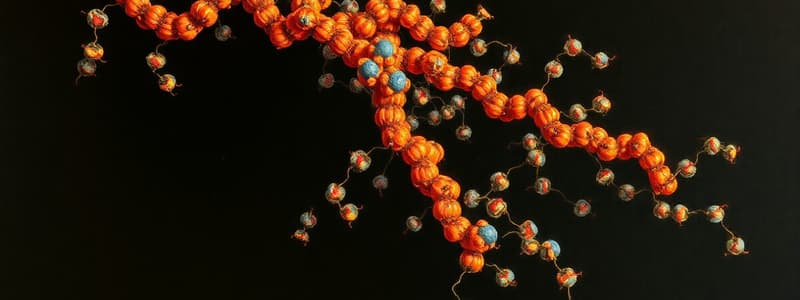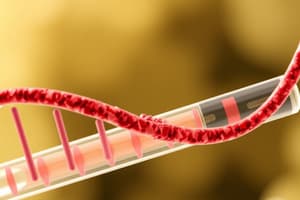Podcast
Questions and Answers
What is the primary purpose of PCR in biotechnology?
What is the primary purpose of PCR in biotechnology?
- To mutate DNA
- To amplify a specific DNA sequence (correct)
- To isolate RNA
- To sequence DNA
Which enzyme is crucial for the PCR process?
Which enzyme is crucial for the PCR process?
- RNA polymerase
- DNA polymerase (correct)
- Ligase
- Restriction enzyme
During which step of the PCR process does the DNA strands separate?
During which step of the PCR process does the DNA strands separate?
- Cooling
- Denaturation (correct)
- Primer Annealing
- Elongation
What is a critical factor for designing effective PCR primers?
What is a critical factor for designing effective PCR primers?
What happens to the target DNA amount with each cycle of PCR?
What happens to the target DNA amount with each cycle of PCR?
What is the role of AT rich sequences at the ori region during DNA replication?
What is the role of AT rich sequences at the ori region during DNA replication?
What comprises a vector replicon?
What comprises a vector replicon?
Which best describes 'in vivo' expression in the context of recombinant protein production?
Which best describes 'in vivo' expression in the context of recombinant protein production?
What is the aim of producing recombinant proteins?
What is the aim of producing recombinant proteins?
Which type of organism is often associated with the use of plasmids as vectors?
Which type of organism is often associated with the use of plasmids as vectors?
What must be present at the 3' end of a primer?
What must be present at the 3' end of a primer?
What is a direct consequence of using repetitive sequences in primer design?
What is a direct consequence of using repetitive sequences in primer design?
Which enzyme is responsible for cutting DNA during genetic engineering?
Which enzyme is responsible for cutting DNA during genetic engineering?
What is the primary purpose of the ori sequence in a cloning vector?
What is the primary purpose of the ori sequence in a cloning vector?
Which type of sequence is likely to be avoided during primer design to enhance PCR efficiency?
Which type of sequence is likely to be avoided during primer design to enhance PCR efficiency?
How are A-T pairings characterized compared to G-C pairings?
How are A-T pairings characterized compared to G-C pairings?
What term describes the overall process of isolating, modifying, and introducing a gene into a host organism?
What term describes the overall process of isolating, modifying, and introducing a gene into a host organism?
Which of the following products would NOT be a result of an unwanted priming event?
Which of the following products would NOT be a result of an unwanted priming event?
Flashcards
What is PCR?
What is PCR?
A technique that amplifies a specific DNA sequence in vitro, making it suitable for further analysis.
What is the role of polymerase in PCR?
What is the role of polymerase in PCR?
A DNA polymerase enzyme used in PCR to synthesize new DNA strands.
What is the denaturation step in PCR?
What is the denaturation step in PCR?
The process of separating the two strands of DNA by heating, allowing primers to bind.
What is the annealing step in PCR?
What is the annealing step in PCR?
Signup and view all the flashcards
What is the elongation step in PCR?
What is the elongation step in PCR?
Signup and view all the flashcards
ori region
ori region
Signup and view all the flashcards
Vector replicon
Vector replicon
Signup and view all the flashcards
Expression vector
Expression vector
Signup and view all the flashcards
In vivo protein expression
In vivo protein expression
Signup and view all the flashcards
In vitro protein expression
In vitro protein expression
Signup and view all the flashcards
Origin of Replication (Ori)
Origin of Replication (Ori)
Signup and view all the flashcards
Ori Sequence Composition
Ori Sequence Composition
Signup and view all the flashcards
Restriction Sites
Restriction Sites
Signup and view all the flashcards
Selectable Marker
Selectable Marker
Signup and view all the flashcards
Promoter
Promoter
Signup and view all the flashcards
Multiple Cloning Site (MCS)
Multiple Cloning Site (MCS)
Signup and view all the flashcards
Reporter Gene
Reporter Gene
Signup and view all the flashcards
Cloning Vector
Cloning Vector
Signup and view all the flashcards
Study Notes
Basic Biotechnology Techniques
- Polymerase Chain Reaction (PCR) is an in vitro technique that amplifies specific DNA sequences.
- PCR uses DNA polymerase to amplify small amounts of DNA for further testing.
- PCR products are substrates for the next reaction cycles.
- PCR is a transformation of a set of substances.
- Kary Mullys received the Nobel Prize in Chemistry in 1993 for PCR.
PCR Procedure
- PCR involves three main steps: denaturation, annealing, and extension.
- Denaturation (94°C): Separates the DNA double helix into two single strands.
- Annealing (57°C): Primers bind to their complementary sequences on the single strands.
- Extension (72°C): DNA polymerase extends the primers using nucleotides, creating new DNA strands. It's repeated approximately 30 times.
- The number of DNA copies doubles in each cycle (e.g., 230 copies)
- DNA template with a sequence of interest
- Primers
- dNTPs
- Polymerase
- Mg2+
- The cycle (denaturation, annealing and elongation) is repeated approximately 30 times, doubling the amount of target DNA each time.
PCR Essentials
- DNA Sample
- dNTPs (dATP, dGTP, dCTP, dTTP)
- Forward primer
- Reverse primer
- Enzyme (Taq Polymerase)
- Mg2+
PCR Principles
- PCR takes a specific DNA sequence and amplifies it
- DNA polymerase is used in the process
- One reaction product becomes the next reaction's substrate
- Transformation of a set of substances
Primer Design
- Primer length is typically 15-30 nucleotides.
- Primer G+C content is 40-60%.
- The melting temperatures (Tm) of forward and reverse primers should not vary significantly.
- Avoid repetitive or complementary sequences to prevent primer dimers or unproductive PCR.
- Repetitive sequences can lead to primer dimers or unproductive PCR.
- Avoiding these types of sequences helps ensure PCR efficiency and specificity.
Cloning
- Gene Cloning is the process of isolating and copying a gene of interest from an organism's DNA.
- Creating many copies of a gene of interest.
- Using a plasmid vector to insert the gene.
- The resultant protein expression using gene cloning depends on cellular conditions.
Genetic Tools - Enzymes
- Methylases: Modify DNA.
- Endonucleases: Cut DNA.
- Ligases: Paste DNA.
- Quinasies: Phosphate addition
- Phosfatases: Phosphate elimination
- Polymerases: Synthesis of DNA
- Exonucleases: Degrade DNA
General Cloning Protocol
- Cut DNA fragments using restriction enzymes.
- Anneal (join) the DNA fragment to the plasmid.
- Seal the gaps in the plasmid (join) using DNA ligase to make the plasmid.
- The resulting recombinant plasmid containing the gene of interest is introduced into a host cell (e.g., bacteria).
- These cells replicate the plasmid, thereby producing multiple copies of the desired gene.
Cloning Vector Elements
- Antibiotic resistance (AR) gene allows selection of successful clones.
- Multiple Cloning Site (MCS) contains unique restriction enzyme cutting sites to facilitate insertion.
- Ori (Origin of replication) regulates plasmid replication inside host cell.
- pUC19 is a common Cloning Vector which contain AR, MCS, and Ori
Cloning Vector Elements - Additional notes
- Vectors need necessary nucleic acid sequences for replication in the host cell.
- The sequence (ori) initiates replication.
- A sequence rich in A and T but poor in G and C in the replication origin allows for easy DNA strand separation.
- Important regulatory and initiation proteins.
- DNA polymerase for replication
Expression Vectors
- Used for high-level production of proteins of interest.
- Contain a strong promoter for efficient gene transcription.
- Include a ribosome binding site (RBS) for efficient translation initiation.
- May include a selectable marker to identify cells carrying the expression vector.
- A termination region.
- A polyadenylation signal.
- pGEX-123 is an example of an expression vector.
Protein Overexpression
- Bioproduction of recombinant protein in a certain amount for various purposes (research, biomedical, pharmaceutical, etc.)
- Maintains native protein properties
Protein Overexpression Methods
- In vitro: Transcription and translation using cell extracts
- In vivo: Introduces DNA coding sequences into a cell lineage
Protein Purification
- Multi-step process for separating protein of interest from a mixture of proteins.
- Separation techniques depend upon protein properties
- General scheme: Protein release, contaminant removal, selective separation, characterization.
Protein Purification Techniques
- Different methods based on solubility, electric charge, polarity, size/mass, and binding specificity are used.
- Techniques like precipitation, chromatography, electrophoresis, and affinity chromatography are common.
Recombinant Protein
- Recombinant proteins are created by inserting a gene of interest into a suitable vector.
- Subsequently, the expression of the inserted gene yields protein products in the host cell in large quantities.
Protein Quality Control
- Quality control is important to ensure research integrity
- Wasteful resource use.
- Wrong conclusions should be avoided
Factors Affecting Recombinant Protein Expression
- Promoter efficiency
- Translation starting sequences
- Codon usage
- mRNA structure
- Plasmid copy number
- Plasmid stability
- Host cell physiology
Protein Characterization
- Used to determine physical, chemical, and biological properties of a purified protein.
- Methods include absorbance, fluorescence, circular dichroism (CD), dynamic light scattering (DLS), and differential scanning calorimetry (DSC).
Organisms for Expression Vectors
- Bacteria
- Yeasts
- Insect cells
- Mammalian cells
- Plants
- Animals
- Baculovirus
Protein Expression in Yeast (Pichia pastoris)
- Pichia pastoris is a methylotrophic yeast, utilizing methanol as a carbon source when glucose is absent.
- The AOX1 promoter is used.
Protein Expression in Yeast (Pichia pastoris) - continued
- AOX1 has low specific activity, but it's expressed in substantial amounts.
- In the presence of large amounts of methanol.
- Alcohol Oxidase is a critical enzyme in this process.
Protein Expression in Yeast (Pichia pastoris) - continued
- Important for protein processing, folding, and post-translational modifications
- Some vectors allow cloning of genes near the AOX1 promoter allowing easy construction.
- A promoter inactive in the presence of glucose, but inducible in the presence of methanol offers a controlled environment for protein production.
Baculovirus as Expression System
- Baculoviruses are insect viruses that can be used to express proteins in insect cells.
- Recombinant viruses are formed by introducing a gene into a suitable virus vector.
- The main advantage is virus multiplication within host cells without causing occlusion bodies.
Plants as Expression Systems
- Agrobacterium tumefaciens is a soil bacterium.
- The plasmid Ti from A. tumefaciens is used to transform plants.
- The T-DNA from Agrobacterium contains the gene of interest, integrated into the plant's genome, which is then further processed. Methods for further processing vary based on the specific desired product.
Transgenic Animals
- Transgenic animals with a gene of interest inserted into their genome are used for expression systems.
- Several methods exist and procedures vary based on desired outcome.
PCR in detail
- Basic process detailed in a diagram.
- Separate steps and requirements for PCR process including the use of enzymes and specific temperatures required.
- Explain in clear terms the importance of each step and how the process works.
Studying That Suits You
Use AI to generate personalized quizzes and flashcards to suit your learning preferences.




